The Wonderful World of Designer Cristina Celestino
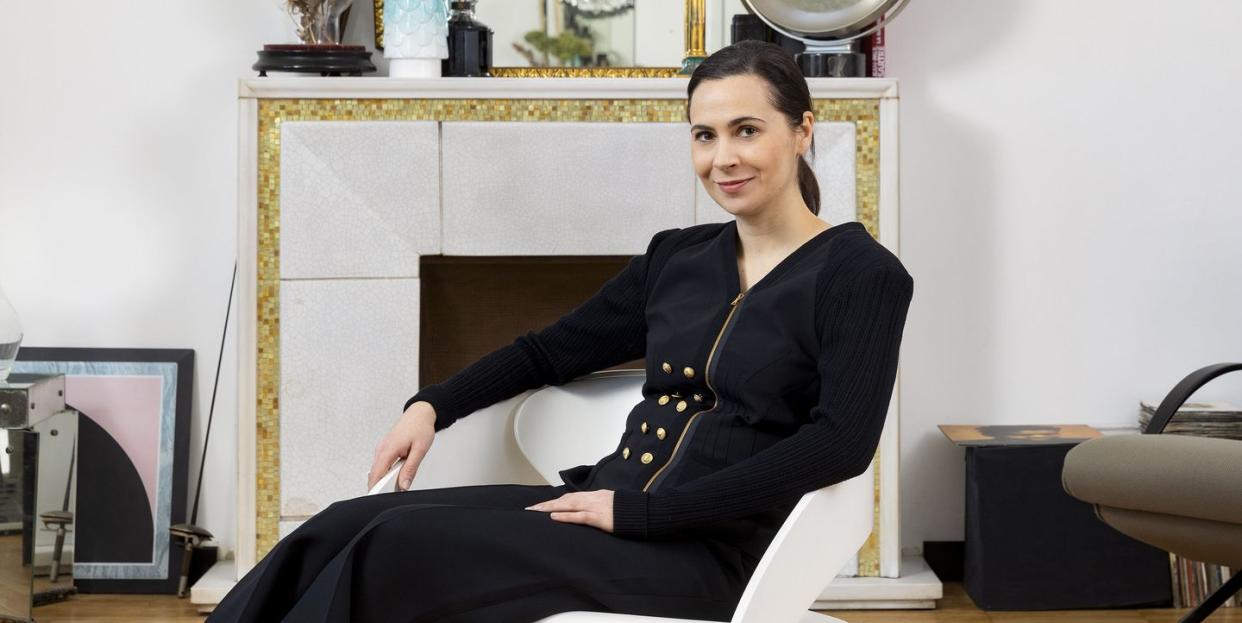
Cristina Celestino has a penchant for conjuring worlds in pastel colors with a touch of nature’s wonders: multiplying coral, creatures from both sea and land, and candied fruits. Tinged with irony and a soft femininity, her retro-futuristic stylings and rigid geometries shine through products and spaces overflowing with rich materials like ceramics, marbles, and carpets.
Born in 1980, the Friuli native is now a heavy-hitting regular on the design scene in Milan, where she quickly earned a spot as one of the most delicate and bold voices of design and interiors today.
Rubelli, Fendi, CEDIT, Sergio Rossi…the collaborations and art direction of Cristina Celestino often explore diverse materials and production processes that range from the artisanal to industrial, and from fabrics to chests and large ceramic slabs.
We connect with Cristina by telephone on a morning in mid-March, as the designer is busy at work preparing for new projects to be presented at Milan Design Week 2019.
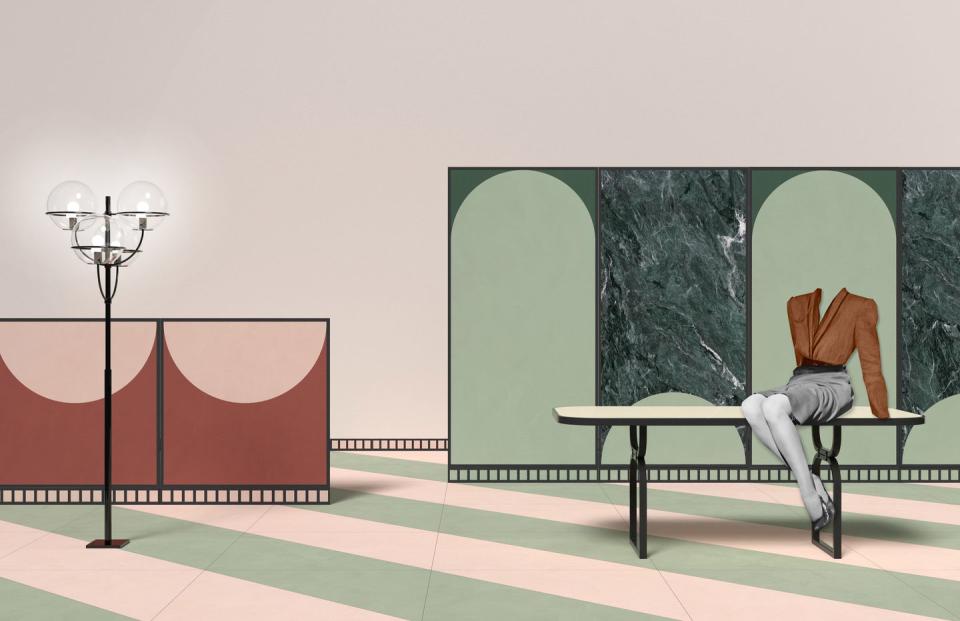
You’ve recently signed off on the Policroma collection for CEDIT: ceramic cladding intended for interiors. How did that collaboration come about?
I was contacted by them and it was the first time I’ve ever worked with a company on such a large scale, with such an extraordinary capacity for industrial production. The story behind CEDIT is what pushed me to accept the challenge, even though the company of today is vastly different than what it used to be. With designers like Ettore Sottsass and Sergio Asti, they were the first to experiment in the field of ceramic cladding that wasn’t artisanal, but rather something technologically advanced-prints and molds instead of manual decorations.
What was the inspiration for your work with them?
Something between the entrances of Milanese apartments and Carlo Scarpa.
On one hand, your architectural studies in Venice and Carlo Scarpa. On the other, your adopted city, Milan.
Exactly. My design references are always moving between my studies, the world of architecture, the great maestros-especially the work of Carlo Scarpa-and that which I’ve become: my passions connected to the city of Milan, from designing collections to the city itself, and accents from the worlds of fashion and jewelry.
With CEDIT, their technical abilities were crucial in the industrial work with ceramics, which is able to transform the surfaces of ceramics into other materials. I decided to use this to obtain surfaces imitating marble and marmorino.
How did this idea come about?
In the case of the marmorino slabs, the reference comes from the marmorino of Carlo Scarpa, while in the case of the marble, I decided to print those that are starting to disappear-which I chose very carefully. They were all Italian marbles that are beginning to go extinct, but that were used often in the past by the great maestros. We printed, for example, the Rosa Valtoce marble, which was used for the Duomo of Milan and traditional buildings in the city.
My idea was to take advantage of the company’s skill in printing, but also to save these quarries, which are very small. In this way, we’re able to carry on using these prized marbles without having to further damage the natural environment.
The marbles I printed on CEDIT surfaces include Verde Alpi, Rosa Valtoce, Cipollino Ondulato, and the Breccia Capraia.
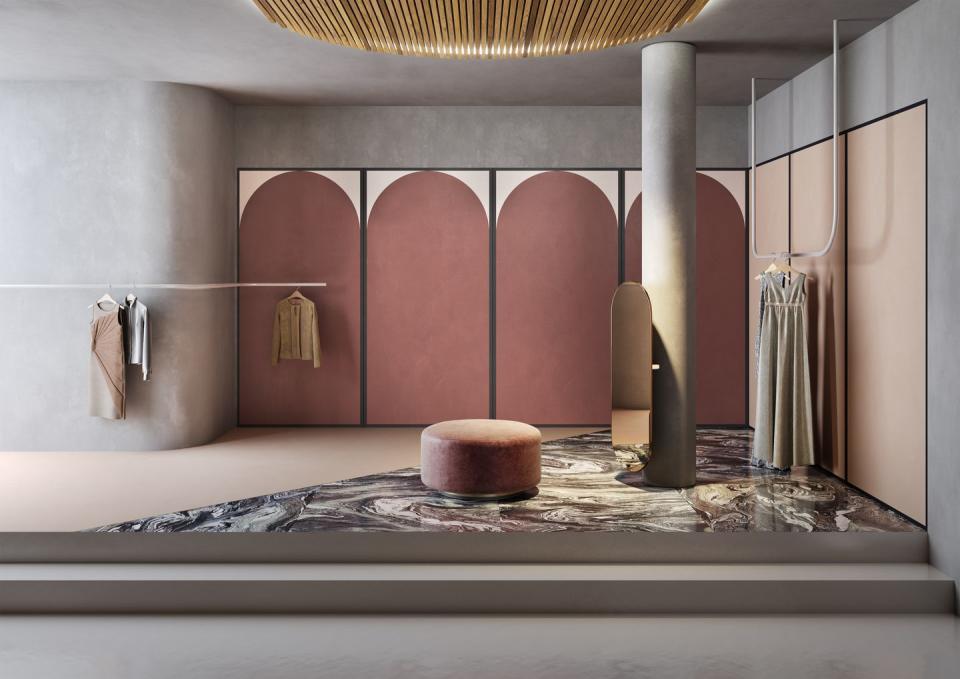
Does this knowledge and passion for marble come from your studies in architecture school?
It’s something I’ve developed over the years. I became passionate about Cipollino for a project of mine looking at Adolf Loos, who used it in the American Bar of Vienna, as well as in many private residences.
Meanwhile, Rosa Valtoce was one I encountered in the entrances of Milan, just like the Verde Alpi used by Gio Ponti.
You print marble onto ceramics, playing with the illusion and reality of the two materials.
I wanted to lay out this idea of the “fake” by introducing a border: all the slabs are outlined with a printed frame in opaque black iron sheet, like those used by Carlo Scarpa in his marmorino surfaces.
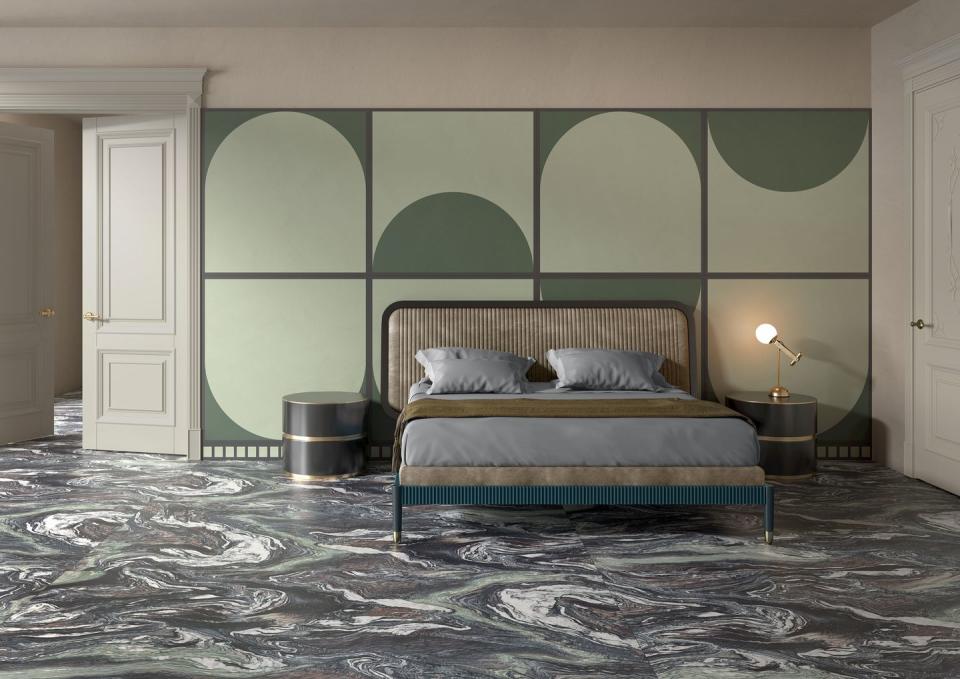
What else will you be presenting for Design Week? On Instagram you’ve announced a project with Cucchi, the historic Milanese bakery and café in Corso Genova: Caffè Concerto. The photo of musicians with a pear and apple looks interesting!
It’s a special project: one part of the curation will be temporary, for MiArt and the Salone, while the other will remain as a new part of the interiors. I studied tables in Budri marble for the exteriors, while interiors will feature original tables with antique colored mirrors.
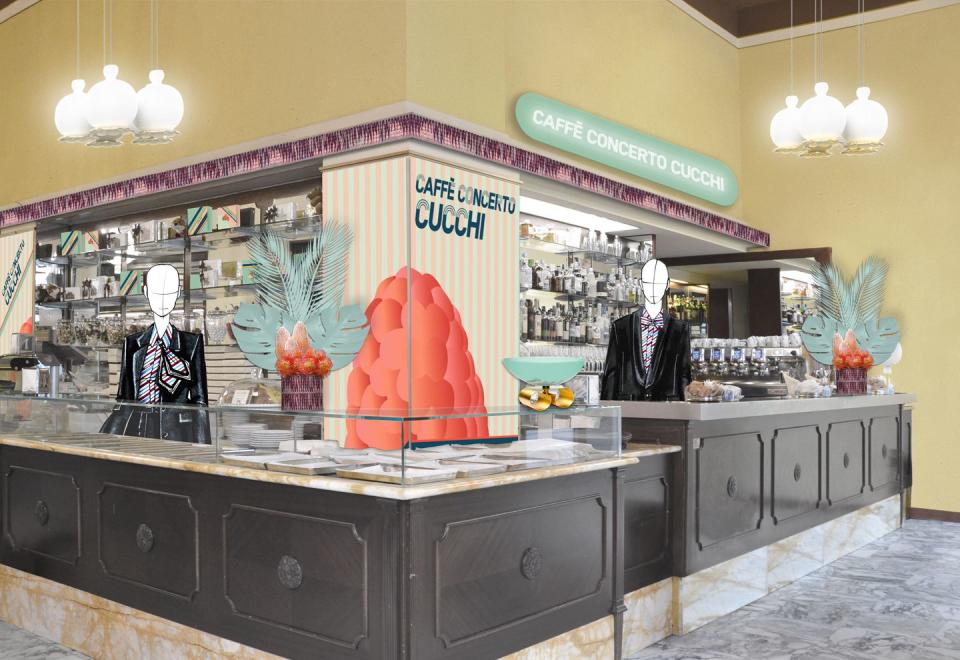
Why “Caffè Concerto”?
The name alludes to the origins of the Cucchi bakery, which was founded in the 30’s under that name. I began with the theme of the Italian and Parisian “caffè concerto,” which was then freed to move into a more surreal place, stealing inspiration from the world of the bakery and the aesthetic of sweets. To that, I then added abstract objects that transform the space. It’s a bourgeois environment with colorful, fresh (which I call Canditi) elements that render the locale more contemporary.
And in Brera you’re presenting Planetario.
Yes, in the Brera Design Apartment-the central hub of the Brera District. It’s a project with Besana Carpet Lab in collaboration with Esperia, a historic Tuscan lighting company. I’ve reproduced retro-futuristic interiors that include an intense and often “outside the box” application of carpeted surfaces, mixing colored backgrounds with a new printed carpet.
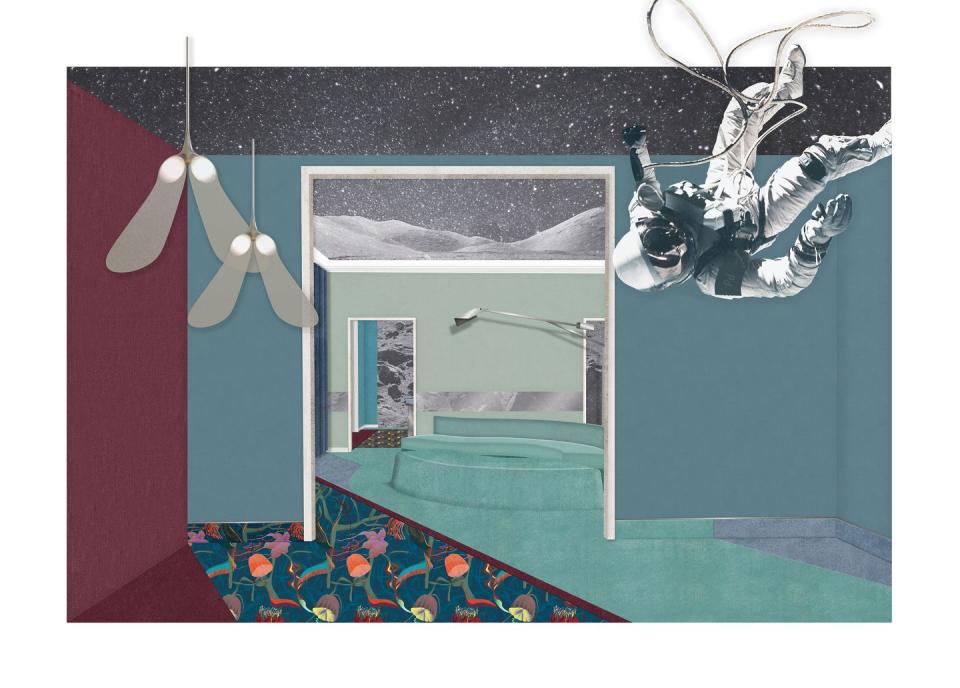
Carpet is back!
I’m very happy. I’ve had it in mind for years.
The retro-futuristic atmosphere seems to be a recurring theme of yours. Looking at your Instagram profile, you often post photos with this kind of feel, like the dress from Valentino.
I should dress like this for Planetario!
#love 💙 @maisonvalentino @pppiccioli 🔭🌠🌑💫 #retrofuture
A post shared by Cristina Celestino (@cristinacelestino) on Feb 15, 2019 at 4:35am PST
Fashion is a strong suit of yours, both personally and professionally. Back in 2016, you collaborated with Fendi at Design Miami and this past year, you crafted the interiors of the Sergio Rossi boutique.
If only you could see how I’m dressed now! This morning, I refused to go into the office because I needed to work in peace at home.
Where is your office?
Near my home, here in Piola.
Fashion, I wanted to ask…
I really love fashion-it’s a space I always feel very free in. The brands are coherent, with creative languages and a strong sense of history, like Fendi. But they also know how to keep renewing themselves.
A world that moves quickly.
In design, there’s still a lot of fear. Everything is very slow, even though we’ve realized we need to move faster. In fashion, there’s this freshness, even just in choosing a color palette. I think leather products are fascinating and bags can almost be considered examples of micro-architecture.
It would be nice to see you working on something in fashion!
Soon!
When can you tell us more?
I’m not sure yet, but I’ll present a collection of furnishings for Fendi Casa under Silvia Venturini Fendi, who was really passionate about the project and followed it personally. It’s called Back Home. We’ll be presenting it in Via Solari, where Fendi holds its runway shows. I’m also working on the curation.
You’ll be in a lot of places at once for Design Week!
I know. I was thinking of just escaping to Friuli!
The world of Cristina Celestino seems to embody this feminine, delicate touch, which perhaps reflects your philosophy on life? It reminds me of the title for your project at Fendi, The Happy Room.
It’s a question I often get. I don’t know…I think my world of reference, whether I like it or not, comes from this feminine imagery, from furnishings with a vanity table to greenery with flowers.
A kind of retro-futuristic world in pastels as we mentioned before.
It’s a mix of my passions and my personal aesthetic based on colors and textures. Together, these end up creating a universe that also embraces a sense of the ironic.
The ability to maintain a strong personality and stylistic identity.
What’s helped me over the years is perhaps consistency: clients ask me to do what I know how to do-they’re looking for my creative language.
Which each time is met with the company for whom you’re working.
Of course. I’m myself but I also look to understand the materials and the world of my clients. Looking at The Happy Room or the boutique for Sergio Rossi, although they come from the same hand, they’re vastly different. Each project is born and developed in that moment for the needs of the client.
And the names of collections and objects: The Happy Room, Planetario, Candidi, Back Home… A sensation and an atmosphere is already created with the title.
I always dedicate a lot of time to find the right name. It’s what tells the story and inspiration of each project. For me, it’s fundamental.
Back to Design Week, which is just around the corner. How long have you been at work?
It depends. With CEDIT, for example, we began a long time ago. Other collaborations have been developed faster. With Fendi Casa, we worked more at the pace of fashion, and I already knew Besana Carpet Lab from last year with the Corallo Tram.
Milan, the city that has adopted you-or you it. Being from Pordenone, you studied at Venice’s IUAV, but did you come to Milan right after graduating?
No…I went first to Florence, because the professor I did my thesis with, Massimo Carmassi, had his studio there.
What did you do your thesis on?
A female prison in Venice.
So returning to this feminine theme. And from Florence, how did you make your way to Milan?
I worked in architecture and then had a brief experience in Rome, but it wasn’t the right place for me. Sending resumes to Milan, I ended up working for Sawaya & Moroni, where I stayed for two years. On nights and weekends, I would work on my own things. Then in 2012, I participated in SaloneSatellite and since 2014, I’ve worked full time with my own studio after the birth of my daughter.
Final question: what would you suggest for those visiting Milan during MiArt and Design Week?
Hmmm, I would say without a doubt, the Massimo De Carlo Gallery, hosted in the building by Piero Portaluppi. Then, I personally love the Rotonda della Besana, with its enclosed lawn in the heart of the city. And a visit to the Triennale is an absolute must. As for going out, Potafiori is a favorite of mine.
MILAN DESIGN WEEK 2019 WITH CRISTINA CELESTINO
Policroma – CEDIT Space, Via Foro Buonaparte 14/14a - and Salone del Mobile, Rho Fiera, Pav. 24, booth B02
Caffé Concerto Cucchi - Cucchi, Corso Genova 1, April 3-29
Planetario - Brera Design Apartment, Via Palermo 1 - April 8-14
Back Home for Fendi Casa - Fendi showroom, Via Andrea Solari 35, April 9-14
Scenografia - Fornace Brioni, Via Statuto 18, April 9-14
('You Might Also Like',)


